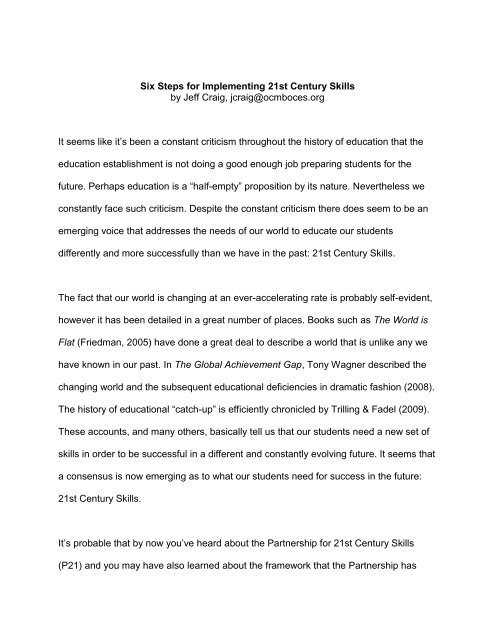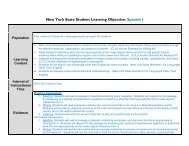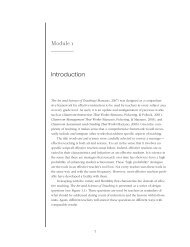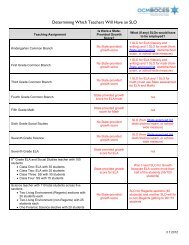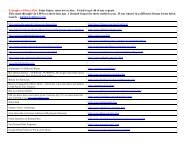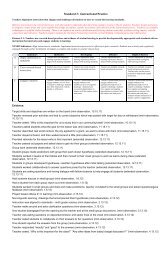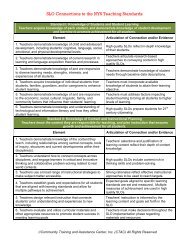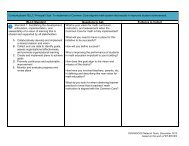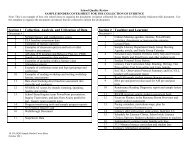Six Steps for Implementing 21st Century Skills - OCM Boces
Six Steps for Implementing 21st Century Skills - OCM Boces
Six Steps for Implementing 21st Century Skills - OCM Boces
Create successful ePaper yourself
Turn your PDF publications into a flip-book with our unique Google optimized e-Paper software.
<strong>Six</strong> <strong>Steps</strong> <strong>for</strong> <strong>Implementing</strong> <strong>21st</strong> <strong>Century</strong> <strong>Skills</strong><br />
by Jeff Craig, jcraig@ocmboces.org<br />
It seems like it’s been a constant criticism throughout the history of education that the<br />
education establishment is not doing a good enough job preparing students <strong>for</strong> the<br />
future. Perhaps education is a “half-empty” proposition by its nature. Nevertheless we<br />
constantly face such criticism. Despite the constant criticism there does seem to be an<br />
emerging voice that addresses the needs of our world to educate our students<br />
differently and more successfully than we have in the past: <strong>21st</strong> <strong>Century</strong> <strong>Skills</strong>.<br />
The fact that our world is changing at an ever-accelerating rate is probably self-evident,<br />
however it has been detailed in a great number of places. Books such as The World is<br />
Flat (Friedman, 2005) have done a great deal to describe a world that is unlike any we<br />
have known in our past. In The Global Achievement Gap, Tony Wagner described the<br />
changing world and the subsequent educational deficiencies in dramatic fashion (2008).<br />
The history of educational “catch-up” is efficiently chronicled by Trilling & Fadel (2009).<br />
These accounts, and many others, basically tell us that our students need a new set of<br />
skills in order to be successful in a different and constantly evolving future. It seems that<br />
a consensus is now emerging as to what our students need <strong>for</strong> success in the future:<br />
<strong>21st</strong> <strong>Century</strong> <strong>Skills</strong>.<br />
It’s probable that by now you’ve heard about the Partnership <strong>for</strong> <strong>21st</strong> <strong>Century</strong> <strong>Skills</strong><br />
(P21) and you may have also learned about the framework that the Partnership has
constructed to illustrate the <strong>21st</strong> <strong>Century</strong> <strong>Skills</strong>. You’ve likely seen the rainbow in<br />
concentric pools icon that is associated with <strong>21st</strong> <strong>Century</strong> <strong>Skills</strong>. The rainbow part of the<br />
graphic is intended to show the things we want our students to know, be able to do, and<br />
be like – the student outcomes. The rainbow includes content, interdisciplinary<br />
connections, various literacies, and skills. The rainbow is supported by the foundation of<br />
curriculum, assessment, instruction, and professional development that are all needed<br />
to teach the qualities described in the rainbow to our students – the support systems.<br />
The support systems are the conditions necessary to attain the student outcomes.<br />
There are some misconceptions that should be addressed be<strong>for</strong>e we more closely<br />
examine the <strong>21st</strong> <strong>Century</strong> <strong>Skills</strong>. From experience, many under-in<strong>for</strong>med people seem<br />
to think that <strong>21st</strong> <strong>Century</strong> <strong>Skills</strong> are all about technology. This is not true; technology is<br />
just a small part of <strong>21st</strong> <strong>Century</strong> <strong>Skills</strong>. In fact, Ken Kay, President of the Partnership <strong>for</strong><br />
<strong>21st</strong> <strong>Century</strong> <strong>Skills</strong>, recently issued this tweet: “One of the biggest misunderstandings is
those who equate technology with <strong>21st</strong> century skills (personal communication, 2010).”<br />
It’s tempting to paint <strong>21st</strong> <strong>Century</strong> <strong>Skills</strong> with the technology brush. After all, technology<br />
and Web 2.0 are altering our landscape at breathtaking speed. It’s hard to keep up with<br />
all that is changing. Yet, technology is just a small part of the story.<br />
Other misconceptions are that <strong>21st</strong> <strong>Century</strong> <strong>Skills</strong> are new things that high-tech<br />
companies are <strong>for</strong>cing on us (Sawchuk, 2009), or that the liberal and classical western<br />
education that made our country great will be lost in the haste to make way <strong>for</strong> <strong>21st</strong><br />
<strong>Century</strong> <strong>Skills</strong> (Ravitch, 2009). Ravitch labels <strong>21st</strong> <strong>Century</strong> <strong>Skills</strong> as a fad similar to<br />
those that have come and gone throughout the 20th century. A careful examination of<br />
<strong>21st</strong> <strong>Century</strong> <strong>Skills</strong>, at least as defined by the Partnership <strong>for</strong> <strong>21st</strong> <strong>Century</strong> <strong>Skills</strong>,<br />
indicates that this simply is not the case. <strong>21st</strong> <strong>Century</strong> <strong>Skills</strong> are many of the same skills<br />
we have desired <strong>for</strong> our students <strong>for</strong> generations and generations.<br />
<strong>21st</strong> <strong>Century</strong> skills are the things that students need to know, be able to do, and be like<br />
in order to succeed in the <strong>21st</strong> <strong>Century</strong>. It is important to note that these things aren’t<br />
any different than the things that students needend to know, be able to do, and be like<br />
in the 20th <strong>Century</strong>. Remember the SCANS (Secretary’s Commission on Achieving<br />
Necessary <strong>Skills</strong>) report? What about the Universal <strong>Skills</strong> that are detailed in New York<br />
State’s CDOS Standard 3A? There is a great deal of similarity between these<br />
documents and the <strong>21st</strong> <strong>Century</strong> <strong>Skills</strong>. They all describe the skills our students need in<br />
order to succeed in college or career. Most of these things did not change or suddenly<br />
become important when the calendar was flipped to a new century. Rather, these are
the skills, attitudes, and dispositions that our students have always needed – it’s just<br />
that here we are in the <strong>21st</strong> <strong>Century</strong> and our students still don’t have them!<br />
Although there are many different lists of skills (see Bill Coplin’s article in this issue),<br />
each is an attempt to make explicit the things that our students should be able to do. If<br />
the skills are explicit it is far more likely that they will be included in curricula and<br />
programs. The most accepted list of skills is the Framework from the Partnership <strong>for</strong><br />
<strong>21st</strong> <strong>Century</strong> <strong>Skills</strong> – that rainbow that is increasingly used to symbolize attention to<br />
skills. That framework (detailed elsewhere in this issue, also) lists the knowledge, skills,<br />
and expertise that students should master to succeed in work and life.<br />
If schools and districts are truly committed to college, career, and citizinship readiness,<br />
an active and deliberate ef<strong>for</strong>t must be undertaken to ensure that <strong>21st</strong> <strong>Century</strong> <strong>Skills</strong> are<br />
at the heart of our educational programs. This is no easy task; most of our schools are<br />
organized around content and not skills. There are some steps that can be taken,<br />
though, to accomplish this <strong>for</strong>midable yet vital realignment.<br />
How is a district to deliberately implement <strong>21st</strong> <strong>Century</strong> <strong>Skills</strong>? Based loosely on the<br />
partnership <strong>for</strong> <strong>21st</strong> <strong>Century</strong> Skill’s “<strong>Six</strong> <strong>Steps</strong> to Build Momentum,” the Onondaga-<br />
Cortland-Madison BOCES Instructional Support Services division has identified “6<br />
<strong>Steps</strong> to Implement <strong>21st</strong> <strong>Century</strong> <strong>Skills</strong>.” These six steps are detailed here:<br />
Step 1: Increasing Awareness<br />
It is important that all members of the educational community understand and believe in<br />
a vision of <strong>21st</strong> <strong>Century</strong> Learning. An understanding of our changing world and the
changing postsecondary landscape is critical. There is no shortage of voices arguing <strong>for</strong><br />
changes in the way we prepare students.<br />
In this first implementation step, a variety of activities, strategies and tools can be used<br />
to create the broad support needed <strong>for</strong> change. Activities can be done at the team,<br />
school, or district level. Indeed, a combination of these is probably most likely to build<br />
awareness throughout the organization. Activities, too, should be done with parents,<br />
community, and business leaders in order to increase awareness about <strong>21st</strong> <strong>Century</strong><br />
<strong>Skills</strong> and to build a critical mass of support and urgency. There any many reports and<br />
white papers that can be used to create a sense of urgency, but a good starting point is<br />
to begin with these three questions (Partnership <strong>for</strong> <strong>21st</strong> <strong>Century</strong> <strong>Skills</strong>, 2010):<br />
1. What are the two or three biggest changes in society in the last 25-30 years?<br />
2. What are two or three skills that students need to address the changes in society<br />
you described?<br />
3. Looking at the skills listed above, how intentional is your school in helping<br />
students develop those skills?<br />
Invariably, responses to these three questions suggest that there is a mismatch<br />
between the curricula and the programs in our schools. It becomes evident that our<br />
content-based orientation of school is not sufficient to prepare students <strong>for</strong> their (and<br />
our) future.<br />
Step 2: Assessing Your Current State
Once awareness has been established, the next step is to take stock of your present<br />
condition. Districts can use a variety of tools, including some on-line tools, which will<br />
provide specific in<strong>for</strong>mation about the implementation of <strong>21st</strong> <strong>Century</strong> <strong>Skills</strong> in schools<br />
and districts. It is important to look within the district to describe the level of skills<br />
implementation and it is also important to reach out to the educational and business<br />
community <strong>for</strong> their input. These data provide a starting point <strong>for</strong> districts.<br />
A helpful assessment tool is the MILE Guide from the Partnership <strong>for</strong> <strong>21st</strong> <strong>Century</strong><br />
<strong>Skills</strong>. The MILE Guide allows schools and districts to examine their program against<br />
the P21 Framework. Other tools are being used by districts, including the College and<br />
Work Readiness Assessment Project, the <strong>21st</strong> <strong>Century</strong> <strong>Skills</strong> Assessment, and the<br />
iCritical Thinking Assessment . These tools provide districts with specific evidence<br />
about the implementation of specific <strong>21st</strong> <strong>Century</strong> <strong>Skills</strong> (usually the ITC skills of<br />
in<strong>for</strong>mation and technology literacy). While there are not as many assessment tools that<br />
assess skills as there are tools that assess student achievement, there are tools that<br />
can provide concrete skills assessment data.<br />
One of the challenges that arises in schools is that sometimes educators think that they<br />
are "already doing that." This can occur because the definitions of the skills can have<br />
multiple interpretations. For example, teachers can think that they are teaching critical<br />
thinking to students. Yet, a thorough examination might indicate that there is no<br />
deliberate, systems-wide approach to the teaching of critical thinking. The classic<br />
checkerboard metaphor can be applied to this situation. As students move through their<br />
years of education, some students will be in a classroom where critical thinking skills
are addressed more than in others. Each year, as a student moves to another<br />
classroom, the same situation exists with some classrooms paying more attention and<br />
being more deliberate about critical thinking skills than others. So, as a student<br />
progresses from year to year and different class to different class (the checkerboard),<br />
the critical thinking skills work that one child does will vary considerably from the<br />
experience and learning of other children. Some will have been in classrooms where<br />
critical thinking skills were very deliberately addressed every year, while other children<br />
might have never had a lot of work with critical thinking skills – all depending on an<br />
arbitrary path across the checkerboard. The experiences of other students will be<br />
somewhere between these two extremes. It is important that a district have data about<br />
the implementation of <strong>21st</strong> <strong>Century</strong> <strong>Skills</strong> in order to know how to proceed.<br />
Step 3: Narrowing to a Manageable Number of <strong>Skills</strong><br />
Chances are that the assessments used to measure intentional implementation of <strong>21st</strong><br />
<strong>Century</strong> <strong>Skills</strong> in a district or school will indicate that many skills need to be deliberately<br />
addressed. Indeed, different lists of skills that have been offered by organizations and<br />
groups are quite lengthy. The Partnership <strong>for</strong> <strong>21st</strong> <strong>Skills</strong> has identified twenty-five skills<br />
that should be addressed, in addition to core subjects and <strong>21st</strong> century themes<br />
(Partnership <strong>for</strong> <strong>21st</strong> <strong>Century</strong> <strong>Skills</strong>, 2007). Bill Coplin has identified 38 skills necessary<br />
<strong>for</strong> career, college, and citizenship readiness (Coplin, 2003). The NcREL/Metiri/Learning<br />
Point Associates list of skills, enGuage, lists 22 skills (North Central Regional<br />
Educational Laboratory, 2003). The Buck Institute <strong>for</strong> Education actually prepared a<br />
crosswalk of ten different models of skills. No matter which list of skills one employs, the
list is a long one -- too long, in fact, to be useful <strong>for</strong> implementation. Prioritization is an<br />
absolute must. Alison Zmuda suggests that districts identify a “manageable handful” of<br />
skills to begin with (personal communication, 2010). Ken Kay suggests that a district<br />
choose two or three, or even a single skill, to begin with (personal communication,<br />
2010).<br />
The skills a district should include in their “manageable handful” depend on a number of<br />
things. First of all, the data from the assessment are the beginning point. These data<br />
alone, however, are not enough. They should be compared with all of the current district<br />
initiatives and ef<strong>for</strong>ts that are already planned or already underway. Districts should<br />
consult their Professional Development Plan, School/District Improvement Plans, Board<br />
of Education goals, and any other documents that describe change ef<strong>for</strong>ts that are<br />
already underway. It is best to choose the few skills to begin with based on a<br />
juxtaposition of all of these data sources. It is a good idea to make this step in the<br />
process very transparent; otherwise stakeholders could see the ef<strong>for</strong>t to deliberately<br />
focus on skills as another new thing, subject to initiative fatigue. It is important during<br />
this step, as in all the steps, to point out how these skills are not new things, are not<br />
controversial things – they are just the things that we’ve been saying all along are<br />
important; we just haven’t been focusing on them and attending to them deliberately like<br />
we should have been.<br />
Step 4: Planning<br />
By this point in the process districts have built awareness of <strong>21st</strong> <strong>Century</strong> <strong>Skills</strong> and the<br />
need to be deliberate about their instruction. By this point districts have assessed the
state of skills implementation. And, by this point, districts have identified that<br />
“manageable handful” of skills with which to start. The next step, then, is to focus in on<br />
that handful of skills in order to begin to overtly and explicitly include them in the<br />
curriculum.<br />
Successful implementations begin with a common set of definitions. Using a protocol<br />
developed by Allison Zmuda, stakeholders work collaboratively to define their identified,<br />
manageable handful of skills (personal communication, 2010). For example, the Virginia<br />
Beach City Public Schools used this process to define, <strong>for</strong> themselves, in<strong>for</strong>mation<br />
literacy. This is the definition they created: “Use digital technology (networks,<br />
databases, and print materials) in an ethical manner, to identify relevant sources,<br />
evaluate validity, synthesize, analyze, and interpret in<strong>for</strong>mation.” (Zmuda, 2010)<br />
Teachers then use the definition as they plan lessons and units and as they write<br />
curriculum. This definition, as succinct as it may be, is still open to multiple<br />
interpretations. A variety of learning opportunities could be aimed at the goal of<br />
achieving this skill <strong>for</strong> students – each of which would vary in its expectations and<br />
difficulty. There<strong>for</strong>e, another level of specificity is necessary in order <strong>for</strong> the definition to<br />
become an effective operational definition.<br />
Once the definition is agreed upon, four levels are written at the district level to describe<br />
a continuum of skill levels. For example, consider these descriptions of skill levels from<br />
Virginia Beach:<br />
Novice
Explore simple questions through the completion of a given procedure that<br />
requires location and collection of in<strong>for</strong>mation through navigation of digital<br />
sources and/or text features in order to share in<strong>for</strong>mation with others.<br />
Emerging<br />
Generate questions, locate and evaluate digital and other sources that<br />
provide needed in<strong>for</strong>mation, analyze in<strong>for</strong>mation to verify accuracy and<br />
relevance, categorize in<strong>for</strong>mation using a given organizational structure,<br />
and report findings.<br />
Proficient<br />
Use an inquiry-based process that requires the development of questions,<br />
identification and evaluation of a range of digital and other sources,<br />
analysis of in<strong>for</strong>mation and point of view, identification of significant<br />
in<strong>for</strong>mation and any conflicting evidence, categorization of relevant<br />
in<strong>for</strong>mation using a self-selected organizational structure, and production<br />
and presentation of a verifiable synthesis of research findings that lays the<br />
groundwork <strong>for</strong> conclusion(s) drawn.<br />
Advanced<br />
Use an inquiry-based process that requires the generation and refinement<br />
of specific questions to focus the purpose of the research, evaluation of<br />
digital and other sources from a variety of social or cultural contexts based<br />
on accuracy, authority, and point of view; resolution of conflicting evidence
or clarification of reasons <strong>for</strong> differing interpretations of in<strong>for</strong>mation and<br />
ideas; organization of in<strong>for</strong>mation based on the relationships among ideas<br />
and general patterns discovered; and combination of in<strong>for</strong>mation and<br />
inferences to draw conclusions and create meaning <strong>for</strong> a given audience,<br />
purpose, and task. (Zmuda, 2010).<br />
Once the levels in the continuum have been described, schools and teacher teams can<br />
analyze their lessons and units employing the traditional gap analysis procedures during<br />
which time they compare their present state with the desired state <strong>for</strong> these skills. The<br />
product of the gap analysis might show that certain levels in the continuum are being<br />
adequately targeted by existing learning opportunities but that other levels of the skill<br />
are never targeted. So, concrete suggestions <strong>for</strong> addressing gaps (or overlaps and<br />
redundancies) can be addressed.<br />
Step 5: Implementation<br />
Based on their skill definitions, continua, and gap analyses, districts can now identify the<br />
appropriate action steps <strong>for</strong> their district within their context and long-range plans. It is<br />
impossible to suggest precisely what action steps are best <strong>for</strong> a district to take until all of<br />
the previous steps have been taken. It is likely that an action from this list, or<br />
combination of actions, are the next steps <strong>for</strong> a district:<br />
School Leadership Development, including administration and teacher leadership<br />
Professional Development
Curricula development including scope and sequence delineation, curriculum<br />
mapping, and unit writing<br />
Instructional practice adjustment, such as a greater application of project based<br />
learning<br />
Adjustments to assessment practices, such as greater emphasis on per<strong>for</strong>mance<br />
assessment and electronic portfolio preparation<br />
Revising learning environments to more closely reflect modern-day college and<br />
career settings<br />
Partnership development with nearby businesses<br />
Changes to instructional technology acquisition, training, and application in order<br />
to shift technology use from teachers to students<br />
Alignment of the evaluation and supervision processes<br />
Actions from this list when used to implement the prioritized skills will result in changes<br />
that have to be monitored and assessed.<br />
Step 6: Evaluation and Continuous Improvement<br />
After the implementation steps have been in motion <strong>for</strong> several years it will be time to<br />
make adjustments to the direction and process of skill implementation. Progress will be<br />
made on the implementation of the prioritized handful of skills, so it will be time to start<br />
the process all over again. This process, when used regularly and when a part of the
operational culture of a district, will have an impact of all aspects of operations;<br />
continuous improvement will be a part of the fabric of the district. Thus will all aspects of<br />
the organization benefit from this step-by-step plan to implement <strong>21st</strong> <strong>Century</strong> <strong>Skills</strong>.<br />
More important than the cultural shift of the organization, though, will be the increased<br />
student achievement and the increased college, career, and citizenship readiness of<br />
every student.<br />
In the midst of all the difficult and demanding work that is done in schools, attention to<br />
21 st <strong>Century</strong> <strong>Skills</strong> might seem to be another add-on to a plate that is already crowded<br />
with initiatives, regulations, and mandates. Nothing could be farther from the truth.<br />
Deliberate and systemic attention to <strong>21st</strong> <strong>Century</strong> <strong>Skills</strong> gets to the very heart of why<br />
our system of education exists, which is to prepare our society and our citizens <strong>for</strong> a<br />
better future. We have to stop preparing students <strong>for</strong> their teachers’ past and start<br />
preparing them <strong>for</strong> their future. Using these six implementation steps, districts and<br />
schools can make that happen.
References<br />
Coplin, W. D. (2003). 10 things employers want you to learn in college: the know-how<br />
you need to succeed. Ten Speed Press: New York.<br />
Friedman, T. L. (2005). The world is flat: A brief history of the twenty-first century.<br />
Farrar, Straus and Giroux: New York.<br />
North Central Regional Educational Laboratory (2003). enGauge <strong>21st</strong> century skills:<br />
Literacy in the digital age. Retrieved July 2, 2010, from<br />
http://www.metiri.com/features.html.<br />
Partnership <strong>for</strong> <strong>21st</strong> <strong>Century</strong> <strong>Skills</strong>. (2007). Framework <strong>for</strong> <strong>21st</strong> century learning.<br />
Partnership <strong>for</strong> 21 st <strong>Century</strong> <strong>Skills</strong>: Tucson, AZ.<br />
Ravitch, D. (2009). Critical thinking? You need knowledge. Boston Globe, September<br />
15, 2009. Retrieved December 28, 2009, from<br />
http://www.boston.com/bostonglobe/editorial_opinion/oped/articles/2009/09/15/cri<br />
tical_thinking_you_need_knowledge/.<br />
Sawchuk, S. (2009, December). <strong>Skills</strong> of Business: Questions are being raised about<br />
whether the push <strong>for</strong> '<strong>21st</strong>-century skills' is an attempt by technology companies<br />
to gain more influence over the classroom. Education Week, 29(14), 18-21.<br />
Retrieved December 28, 2009, from ProQuest Education Journals. (Document<br />
ID: 1925545421).
Trilling, B. & Fadel, C. (2009). <strong>21st</strong> century skills: Learning <strong>for</strong> life in our times. Jossey-<br />
Bass: San Francisco.<br />
Wagner, T. (2008). The global achievement gap: Why even our best schools don’t teach<br />
the new survival skills our children need- and what we can do about it. Basic<br />
Books: New York.<br />
Zmuda, A. (2010, March). Virginia Beach City Public Schools draft. Document<br />
presented at a training of the School Library System, Onondaga-Cortland-<br />
Madison Board of Cooperative Educational Services, Syracuse, NY.<br />
Author Jeff Craig is the Assistant Superintendent <strong>for</strong> Instructional Support Services at<br />
the Onondaga-Cortland-Madison BOCES. <strong>OCM</strong> BOCES is a Professional<br />
Development Affiliate of the Partnership <strong>for</strong> 21 st <strong>Century</strong> <strong>Skills</strong>. In addition to his<br />
responsibilities as Assistant Superintendent he is the Director of Research and<br />
Technology <strong>for</strong> the New York State Middle School. His column, Research At A<br />
Glance, appears regularly in the journal, In Transition. He has also had other<br />
articles appear in In Transition, the Middle School Journal, and the ASCD<br />
Curriculum Handbook Insight.


